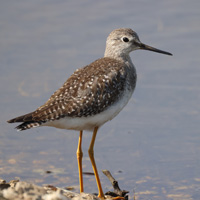Lesser Yellowlegs
Scientific name: Tringa flavipes

Photo credit: Andy Wilson
Status
Threatened
“Threatened” means the species lives in the wild in Ontario, is not endangered, but is likely to become endangered if steps are not taken to address factors threatening it.
Date added to the Species at Risk in Ontario List
January 25, 2023
Read the assessment report (PDF)
What it looks like
The Lesser Yellowlegs is a small shorebird (23 to 25 cm long) with a long neck, greyish plumage, and long, bright yellow legs. It has a straight black bill that is roughly the same length as its head. The wings are dark without barring (a pattern of alternating dark and light stripes running across the feather), and the rump and tail are mostly white.
During the breeding season, individuals have prominent streaking and spotting, while the non-breeding plumage is more washed-out, grey-brown in colour. The Lesser Yellowlegs has a characteristic white eye ring that is always present, but is more noticeable in the winter.
Where it lives
Lesser Yellowlegs is a migratory shorebird. This species breeds in areas across Alaska and northern Canada, stretching from the Yukon to western Labrador. It breeds mainly in boreal wetlands and typically nests on dry ground near wetland areas like peatlands and marshes, which are used for foraging. The species typically forages by walking in shallow water, gathering its prey from the surface of the water or from the mud.
It spends the winters throughout the southern United States and much of Central and South America. During the winter and its migration between its summer and winter ranges, the species frequents:
- coastal salt marshes
- estuaries and ponds
- lakes
- freshwater wetlands
- anthropogenic wetlands, such as flooded rice fields and sewage lagoons
Where it’s been found in Ontario
Lesser Yellowlegs’ breeding range is limited to Alaska and northern Canada, including northern Ontario. Lesser Yellowlegs breed primarily within the:
It can be found throughout central and southern Ontario during its migration between winter and summer habitats.
What threatens it
In Ontario, Lesser Yellowlegs may be threatened by resource extraction that is associated with minor loss or degradation of wetland habitats, such as:
- mining
- quarrying
- peat extraction
Outside of Ontario, Lesser Yellowlegs is threatened by sport and subsistence hunting during migration and on wintering grounds in the Caribbean and South America. It is also threatened by conversion of wetlands to agriculture in important wintering areas, impacting populations over generations.
It is also likely that this species will face emerging threats due to climate change, which includes potential habitat shifts and alterations associated with:
- increased risk of drying of wetlands
- flooding of intertidal habitat in stopover areas, and
- greater severity of hurricanes during migration
Action we are taking
This species and its habitat are protected under Ontario’s Endangered Species Act, 2007 (ESA).
All species listed on the Species at Risk in Ontario List may be eligible for consideration for government funding through the Species at Risk Stewardship Program.
Recovery strategy
A recovery strategy advises the ministry on ways to ensure healthy numbers of the species return to Ontario.
Read the executive summary and the full document (July 9, 2024).
What you can do
Report a sighting
Submit your observations of species at risk to the Natural Heritage Information Centre (NHIC), which is Ontario’s conservation data centre. Join the “(NHIC) Rare Species of Ontario” project in iNaturalist to make submitting your observations quick and easy.
Volunteer
Volunteer with species at risk programs, such as community science surveys, through your local nature club, a provincial park or other conservation organizations.
Be a good steward
Private landowners have a very important role to play in species recovery. If you find species at risk on your land, you may be eligible for stewardship programs that support the protection and recovery of species at risk and their habitats, such as the Species at Risk Stewardship Program.
Report illegal activity
Report any illegal activity related to species at risk to
Quick facts
- An individual Lesser Yellowlegs may migrate up to 30,000 km round-trip between breeding and overwintering areas.
- Approximately 80% of Lesser Yellowlegs breed in Canada.
- Lesser Yellowlegs is monogamous, and females typically lay a single clutch of four eggs each year.